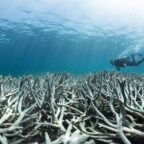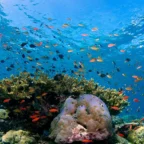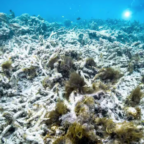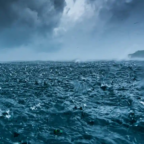
Coral reefs around the globe already are facing unprecedented damage because of warmer and more acidic oceans. It’s hardly a problem affecting just the marine life that depends on them or deep-sea divers who visit them.
If carbon dioxide emissions continue to fuel the planet’s rising temperature, the widespread loss of coral reefs by 2050 could have devastating consequences for tens of millions of people, according to new research published Wednesday in the scientific journal PLOS.
To better understand where those losses would hit hardest, an international group of researchers mapped places where people most need reefs for their livelihoods, particularly for fishing and tourism, as well as for shoreline protection. The researchers combined those maps with others showing where coral reefs are most under stress from warming seas and ocean acidification.
Countries in Southeast Asia such as Indonesia, Thailand and Philippines would bear the brunt of the damage, the scientists found. So would coastal communities in western Mexico and parts of Australia, Japan and Saudi Arabia. The problem would affect countries as massive as China and as small as the tiny island nation of Nauru in the South Pacific.
In many places, the loss of coral reefs would amount to an economic disaster, depriving fishermen of their main source of income, forcing people to find more expensive forms of protein and undermining the tourism industry.
“It means jobs for lots of people,” said Linwood Pendleton, the study’s lead author and an international chair at the European Institute of Marine Studies.
[‘And then we wept’: Scientists say 93 percent of the Great Barrier Reef now bleached]
In addition, many countries depend on coral reefs as a key barrier to guard against incoming storms and mitigate the damage done by surging seas. Without healthy reefs, “you lose what is essentially a moving, undersea sea wall,” said Pendleton, who estimated that about 62 million people live less than 33 feet above sea level and less than two miles from a coral reef. “The waves just come into shore full force. That can cause loss of life. It can cause loss of property.” Some of the countries most dependent on coral reefs are also among the largest polluters.
“Some of the places that have the most to lose . . . are also among the biggest carbon emitters,” Pendleton said. “They really have it in their power to bring down the levels of carbon” they emit into the atmosphere.
Other countries that rely heavily on reefs, such as Fiji or Papua New Guinea, have relatively small carbon footprints. Still, Pendleton said, they can take other measures — including not overfishing and avoiding pollution — to prevent putting further pressure on already stressed reefs.
The researchers acknowledged that more study is needed to better understand both what is happening to coral reefs and how that will affect humans. But it can be difficult, they noted, because “carrying out science and data collection in many of the coral reef regions most at risk of global environmental change is a challenge.” Many regions lack the capacity to do routine data collection, and scientists often have trouble getting permission to sample in coastal areas or where maritime jurisdictions are disputed.
While coral reefs traditionally have been resilient in the face of environmental pressures, mounting evidence suggests their ability to bounce back is limited.
This fall, scientists reported that substantial swaths of the Great Barrier Reef — the world’s largest coral reef system, located off Australia — might have died in the wake of a historic coral-bleaching event.
“The mortality is really devastating,” Andrew Hoey, a senior research fellow with the ARC Center of Excellence for Coral Reef Studies at James Cook University in Queensland, told The Washington Post last month as scientists worked to catalogue the damage. “It’s a lot higher than we had hoped.”
Earlier this spring, researchers discovered that parts of Florida’s coral reef tract — the largest reef in the continental United States and the third-largest barrier reef ecosystem in the world — are dissolving into the water, likely because of the effects of ocean acidification.
Meanwhile, reefs around the U.S. territory of Guam and other nearby islands, in what is known as the Marianas archipelago, have suffered from coral-bleaching events every year since 2013.
And there has been no sign of a break this summer. After a recent dive in Guam’s Tumon Bay, coral ecologist Laurie Raymundo took to Facebook to describe her shock at the devastation.
“I consider myself to be fairly objective and logical about science,” wrote Raymundo, of the University of Guam. “But sometimes that approach fails me. Today, for the first time in the 50 years I’ve been in the water, I cried for an hour, right into my mask, as I witnessed the extent to which our lovely Tumon Bay corals were bleaching and dying.”













Social Profiles